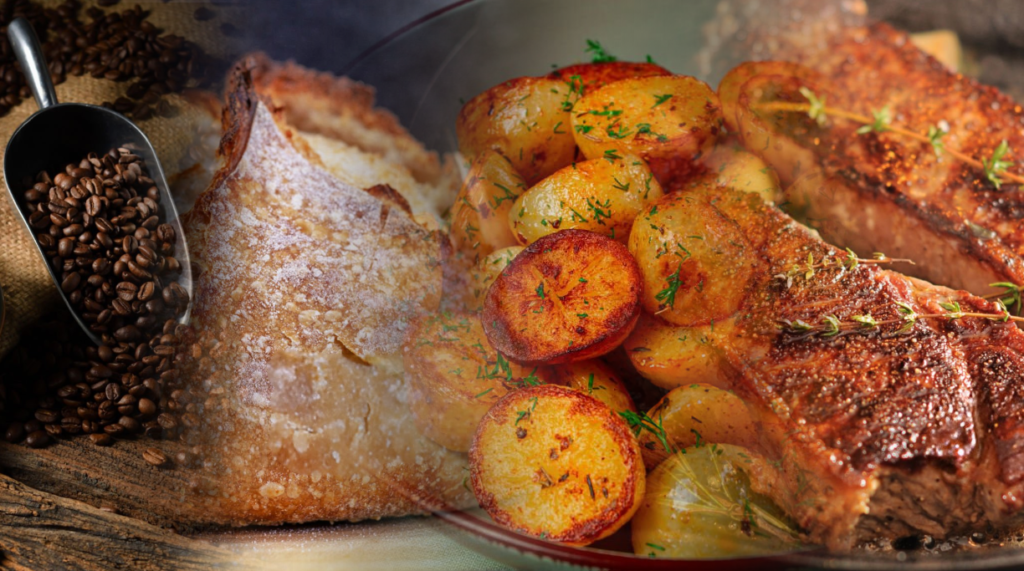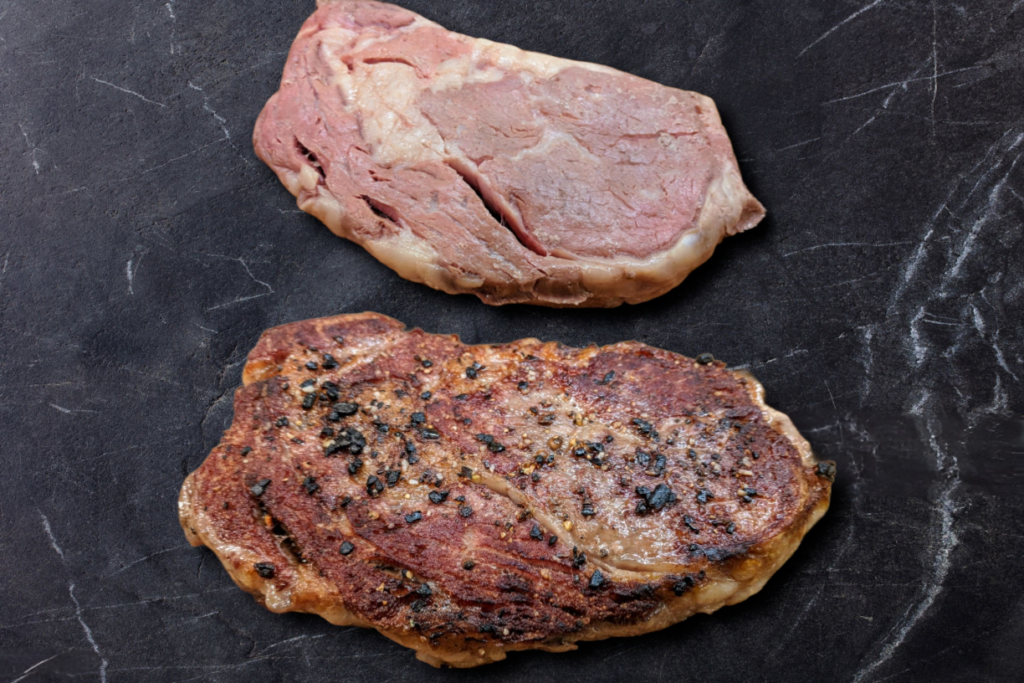Have you ever wondered why a perfectly seared steak tastes so much better than a boiled one? Or why freshly baked bread has that irresistible golden crust? The answer lies in the Maillard reaction—a fundamental process in cooking that creates deep, complex flavors and mouthwatering aromas.
This post contains affiliate links. If you purchase through these links, we may earn a commission at no extra cost to you.
What Is the Maillard Reaction? (And Why Should You Care?)
The Magic of Browning
The Maillard reaction is a chemical reaction between amino acids (the building blocks of protein) and reducing sugars that occurs when food is heated. This reaction is responsible for the browning and rich flavors found in a variety of foods, from grilled meats to toasted marshmallows. Unlike caramelization, which only involves sugar, the Maillard reaction requires both protein and sugar to work its magic.
Foods That Rely on the Maillard Reaction
- Meats: Seared steaks, grilled chicken, roasted turkey
- Breads & Baked Goods: Toast, bagels, crusty artisan bread
- Vegetables: Roasted potatoes, caramelized onions
- Dairy: Toasted cheese, browned butter
- Beverages: Coffee, roasted cacao for chocolate

Understanding how to control and maximize the Maillard reaction in your cooking can elevate your dishes to restaurant-quality levels. Next, let’s dive into the science behind this reaction to better grasp how it works.
The Science Behind the Maillard Reaction
If you love food, understanding a bit of kitchen chemistry can go a long way in making you a better cook. The Maillard reaction isn’t just about heat; it’s a carefully orchestrated dance between proteins and sugars that results in the creation of hundreds of new flavor compounds.
The Chemistry Behind It
When food is heated above 280°F (140°C), the amino acids in proteins interact with reducing sugars in a process called non-enzymatic browning. This reaction produces melanoidins, which are responsible for the deep brown color of cooked foods. Along with color, an array of complex flavor compounds develops, enhancing taste and aroma.
Key Factors That Influence the Maillard Reaction
- Temperature: Higher temperatures speed up the reaction. This is why searing a steak at high heat creates a rich crust quickly.
- pH Levels: A slightly alkaline environment (e.g., adding baking soda) can enhance browning.
- Moisture Levels: Excess moisture prevents browning. This is why drying meat before searing is crucial.
- Cooking Time: The longer food is exposed to the right heat, the more complex its flavors become.
Maillard Reaction vs. Caramelization: What’s the Difference?
The Maillard reaction and caramelization are often confused because both involve browning. However, they are fundamentally different processes that impact food in unique ways.
The Key Differences
| Feature | Maillard Reaction | Caramelization |
|---|---|---|
| Requires Protein? | Yes | No |
| Requires Sugar? | Yes, but from proteins or natural sources | Yes, direct sugar |
| Temperature Range | 280-330°F (140-165°C) | 320-400°F (160-205°C) |
| Common Examples | Seared steak, roasted coffee, toasted bread | Caramelized onions, brûléed sugar, toffee |
Why It Matters in Cooking
- If you want a deep, savory flavor in meat, aim for the Maillard reaction.
- If you’re looking for sweet, rich, and syrupy notes (like in caramelized onions), caramelization is what you need.
- Some foods experience both processes, such as toasted marshmallows and roasted sweet potatoes.
Cooking Hacks to Maximize the Maillard Reaction
Want to master the Maillard reaction in your kitchen? Here are some pro tips to achieve the perfect browning:
1. Keep It Dry
Moisture is the enemy of browning. Always pat meats dry with a paper towel before searing, and avoid overcrowding pans to prevent steaming.
2. Use the Right Temperature
Aim for high-heat cooking methods like pan-searing, roasting, or grilling to hit the optimal Maillard reaction temperature.
- 𝐖𝐢𝐝𝐞 𝐓𝐞𝐦𝐩𝐞𝐫𝐚𝐭𝐮𝐫𝐞 𝐑𝐚𝐧𝐠𝐞: Measure a temperature range from -58°–1130°𝙁 / -50°–610°𝘾 𝙖𝙣𝙙 𝙜𝙚𝙩 𝙮𝙤𝙪𝙧 𝙧𝙚𝙨𝙪𝙡𝙩 𝙞𝙣 0.5 𝙨𝙚𝙘𝙤𝙣𝙙𝙨; Th…
- 𝐕𝐞𝐫𝐬𝐚𝐭𝐢𝐥𝐞 𝐓𝐨𝐨𝐥𝐬: Infrared technology allows you to measure the surface temperature of objects with temperatures above bo…
- 𝐏𝐫𝐨𝐟𝐞𝐬𝐬𝐢𝐨𝐧𝐚𝐥 𝐄𝐌𝐒 𝐌𝐨𝐝𝐞: The Lasergrip 1080 temperature gun has an emissivity range of 0.1–1.0 for precise readings across…
3. Choose the Right Cookware
Cast-iron skillets and stainless steel pans are best for achieving an even, crispy crust.
- PFAS-FREE & NON-TOXIC COOKWARE: Lodge cookware is made without PFOA and PTFE, and we’re proud to say our seasoned cast i…
- ERGONOMIC ASSIST HANDLE & SILICONE PROTECTION: Equipped with an assist handle for easy control and a red silicone hot ha…
- SEASONED COOKWARE FOR EASY COOKING: Lodge pre-seasons every pan with 100% natural vegetable oil, giving it a non-stick f…
4. Experiment with Alkaline Adjustments
A small pinch of baking soda can speed up the Maillard reaction, enhancing browning and flavor.

Final Thoughts: How to Become a Maillard Reaction Master in Your Kitchen
The Maillard reaction is one of the most powerful tools in the culinary world, transforming ordinary ingredients into extraordinary dishes. From the perfect seared steak to the golden crust on freshly baked bread, understanding and controlling this reaction can take your cooking skills to the next level.
To recap:
- The Maillard reaction is responsible for the delicious browning in foods.
- It requires proteins, sugars, and heat to work effectively.
- Proper techniques, such as high heat and dry surfaces, enhance browning.
Now that you’re armed with knowledge, it’s time to put these cooking hacks into action. Try experimenting with different techniques and ingredients in your own kitchen. If you enjoyed this deep dive, check out more culinary science and cooking tips on our blog. Happy cooking! 🍳🔥



Pingback: Unlocking the Secret: How Making Stock is the Foundation of Flavor – Gizmos & Grub
Pingback: The Science of Searing: Why a Cast-Iron Skillet Is Still Your Kitchen’s Secret Weapon – Gizmos & Grub